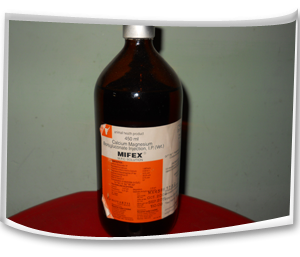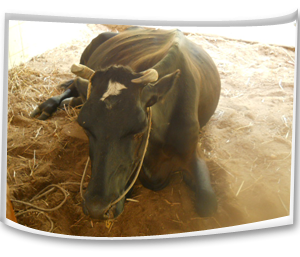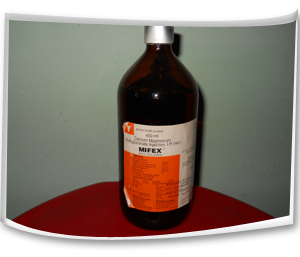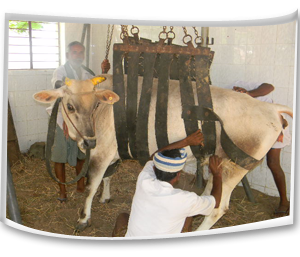|
Metabolic diseases of Cattle and Buffalo
Downer cow syndrome
| Nature of disease |
|
- Affected animals remain bright and alert but are unable to stand.
- This is frequently met in exotic and cross bred dairy cows.
- Most commonly occurs immediately after parturition.
- Most commonly it is a complication of milk fever condition
|
| |
Causes |
 |
- Downer cows are unable to rise after two injections of calcium preparation indicating persistant hypocalcaemia.
- There is low phosphorus level.
- There may be of low blood potassium level. This is often seen in association with hypophosphataemia.
- A low level of blood magnesium has been incriminated as cause but it may develop along with low level of calcium.
- Muscular injury due to too much confinement in the byre, obesity, over feeding during dry period and too much compression of limbs.
- Following parturient paresis a cow may develop downer syndrome due to nerve injuries and over stretching of nerves or due to pressure on nerves while in recumbency.
- The damage of the heart muscle may be attributable to repeated dosing with calcium preparations in milk fever condition.
- Well fed highly obesed cows during later part of pregnancy very often suffer from a condition known as fat cow syndrome which predispose to downer condition.
|
|
 |
| |
Clinical symptoms |
 |
- Cow is inability to rise and remains in recumbent position.
- On stimulation the cow either makes little attempt or no attempt to rise or simply unable to rise even with treatment for milk fever.
- Cow remains bright and alert.
- Appetite, rumination, defecation and urination are usually normal.
- Temperature is usually normal but may turn towards sub-normal range in the terminal stage disease.
- The affected cow usually crawls around utilizing the forelimbs whereas hind limbs remain in flexed position. This type of stance is ascribed as "creeper cow"
- A downer cow which continues to remain down for more than 7 days ends fatally.
|
|
 |
| Preventive measures |
|
- We should provide most comfortable bedding prior to calving and in advanced stage of pregnancy. Sand is the ideal bedding material.
- Early detection and treatment of milk fever.
- Recently calved animals should be monitored at least 48 hours after parturition for the occurrence of milk fever signs.
- Recumbent animals should be treated as soon as possible and not delayed for more than 1 hour.
- Cow should not be mated with a heavy bull. The weight of the bull should be within the weight bearing capacity of the cow. Otherwise there is risk of paralysis and fracture of hip bones.
- The cow should be bred with a bull as per its size as a big calf in a small cow will invite dystokia problem leading to calving paralysis.
- Cow should not be made over fatty through too much feeding during advance pregnancy.
- Cow should be made to stand within a short time following parturition.
- Parenteral Vitamin D3 should be given in milk fever prone cow during pregnant period.
- Low calcium and high phosphorus diet should be given to stimulate parathyroid gland and thus to avoid hypocalcaemia.
- If possible cow of a dairy farm should be brought under metabolic profile test to pinpoint the deficit and to make good use of it.
|

Early calcium treatment for milk fever |

Soft bedding for calved animals |
| |
Control measures |

Calcium and Magnesium Injection |
- Recumbent animals should be treated as soon as possible and not delayed for more than 1 hour.
- Provision of comfortable bedding materials for recumbent animals. Arrangement of soft bed should be made.
- Attempt should be made to roll the cow from side to side to minimize the extent of ischemic necrosis.
- Lift the cow and frequent turning should be made. Cow should be turned at least at 3 hours interval.
- Attempt should be made to lift the cow on its fore legs by using body slings.
- Hip lifters may be used for lift the downer animals.
- With the help of body slings, the animals should be allowed to stand for 20-30 minutes and then lowered down. This should be repeated several times a day.
- Animal’s both fore and hind limbs should be massaged two times per day.
- Downer animals should be milked normally and the udder kept clean by washing with germicide soap before milking and post milking teat dips should be applied.
- Re-placement therapy with Calcium, Phosphorus, magnesium, Glucose containing preparations can be used parenterally by qualified veterinarian.
- Infective causes should be brought under antibiotic coverage.
- Physiotherapy by adopting muscle massage may be made to restore muscle activity of the limbs.
|

Massaaging the legs |

Sling support |
|
 |
|